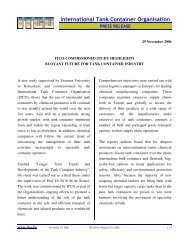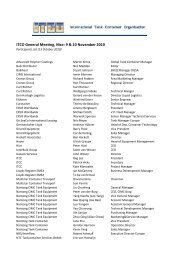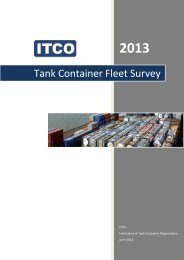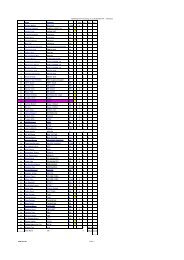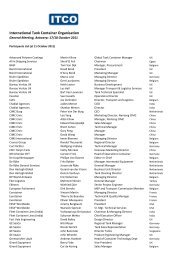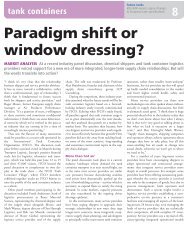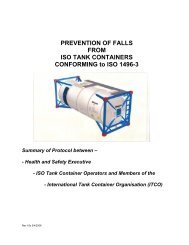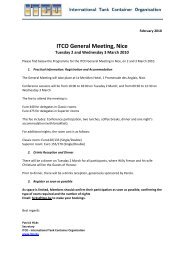You also want an ePaper? Increase the reach of your titles
YUMPU automatically turns print PDFs into web optimized ePapers that Google loves.
ICHCA International <strong>Safe</strong>ty Panel Briefing Pamphlet No 30<br />
11.5.1 <strong>Tank</strong> containers carrying dangerous goods should be positioned so that they<br />
can be clearly seen, protected and removed for isolation should an incident<br />
occur which may place persons in danger.<br />
11.5.2 <strong>Tank</strong> containers should never be placed on rough or stony ground; care<br />
must be taken such that contact by the full bottom surfaces <strong>of</strong> the four<br />
bottom corner fittings is all that is possible. If this is not done, it is possible,<br />
for example, for the container to rest on the bottom outlet valves thereby<br />
risking leakage.<br />
11.5.3 <strong>Tank</strong> containers, for similar reasons should never be placed astride (out <strong>of</strong><br />
use) rail tracks.<br />
11.5.4 When handling tank containers every effort should be made to ensure that<br />
the tank container is landed on level surface free from objects that are likely<br />
to damage the bottom valve assembly.<br />
11.6 The ILO Code <strong>of</strong> Practice on <strong>Safe</strong>ty and Health in Ports states in paragraph<br />
6.3.2 10<br />
“Wherever practicable tank containers should only be stacked one high.<br />
When it is necessary to stack tank containers more than one high it is<br />
recommended that stacking cones be used in view <strong>of</strong> the differences <strong>of</strong><br />
tank container frame designs. <strong>Tank</strong> containers carrying highly volatile<br />
substances should not be stacked over the pressure relief valves <strong>of</strong> highly<br />
volatile flammable substances.”<br />
11.7 <strong>Tank</strong> containers may be stacked higher if adequate precautions are taken to<br />
prevent falling from the stack. This would be determined by carrying out a risk<br />
assessment <strong>of</strong> the area and the securing equipment to be used.<br />
11.7.1 The design <strong>of</strong> tank containers varies as has been shown in section 2 <strong>of</strong> this<br />
pamphlet. When preparing a risk analysis for stacking any type <strong>of</strong> container<br />
on top <strong>of</strong> a tank container, the operator should consider the risk associated<br />
with each design. Failure to stack a container correctly above a tank<br />
container, i.e. corner fitting to corner fitting, may result in the stack toppling.<br />
<strong>Tank</strong> containers without full length top rails, such as the beam, collar and<br />
frame designs, may pose a greater risk <strong>of</strong> toppling however top rails <strong>of</strong> tank<br />
containers are not designed to support a fully laden mis-stacked container.<br />
11.7.2 <strong>Tank</strong> <strong>Containers</strong> may be stacked up to a height that is determined by the<br />
terminal’s own risk assessment and to a height such that the maximum<br />
superimposed load is not exceeded. When completing the risk assessment<br />
due regard should be taken <strong>of</strong> the ILO Code <strong>of</strong> Practice shown in paragraph<br />
11.6 above.<br />
11.8 General Stacking Considerations<br />
11.8.1 The stacking <strong>of</strong> containers relies on the integrity and strength <strong>of</strong> the units.<br />
Stacking also relies on the transfer <strong>of</strong> the load through the corner post<br />
assemblies (comprising <strong>of</strong> the corner post, normally a square steel tube and<br />
a top and a bottom corner fitting, normally cast). No other component or<br />
assembly on any freight container type is designed or tested to<br />
withstand these loads. Therefore it is essential that containers are<br />
stacked corner fitting to corner fitting.<br />
Page 35 ©ICHCA International Limited



